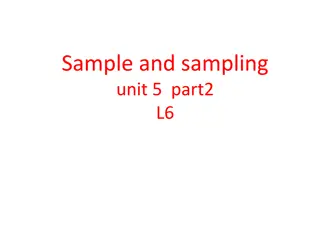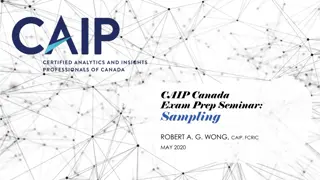Compliance with Audit Documentation
Understand the significance of audit documentation in proving compliance with audit requirements, ensuring quality audit work, and providing evidence for audit conclusions. Learn about the purpose, requirements, and definitions of audit documentation as outlined in auditing standards. Proper documen
7 views • 40 slides
Sampling Methods in Statistical Analysis
Sampling is a crucial process in statistical analysis where observations are taken from a larger population. Different sampling techniques are used based on the analysis being performed. Sampling methods help in studying populations when studying the entire population is not feasible. There are two
0 views • 8 slides
Sampling Under the RRF - General Principles and Methods
Sampling under the RRF is essential for the Commission to ensure reasonable assurance of fulfillment of numerical milestones or targets. The approach involves statistical risk-based random sampling with specific thresholds and considerations for different types of milestones. Various statistical tab
0 views • 12 slides
Non-Probability Sampling Methods
Non-probability sampling methods involve selecting samples based on subjective judgment rather than random selection. Types include convenience sampling, quota sampling, judgmental (purposive) sampling, and snowball sampling. Convenience sampling picks easily available samples, quota sampling select
5 views • 7 slides
Audit Sampling Guidelines and Reference Materials for Internal Auditors
Review authoritative guidance for audit sampling and the potential for external auditor reliance on internal auditors. Understand and apply concepts related to audit sampling to project results with certainty. Available reference materials include AICPA Codification of Statements, AICPA Audit Guide,
9 views • 114 slides
Audit of Ward-based IT Infrastructure at University Hospital of Limerick
In response to a cyber-attack on the HSE in 2021, an audit was conducted at University Hospital of Limerick to assess the accessibility of key healthcare-related computer programs. The audit revealed issues such as JavaScript errors, missing plug-ins, outdated software, and internet access issues. I
0 views • 4 slides
Systematic Analysis of Real Samples in Analytical Chemistry
This analysis covers the systematic process involved in analyzing real samples, including sampling, sample preservation, and sample preparation. It discusses the importance of accurate sampling in obtaining information about various substances, such as solids, liquids, gases, and biological material
0 views • 54 slides
Internal Audit Process & Audit Committees Overview
Explore the functions and responsibilities of internal audit processes and audit committees in the context of school boards in Ontario. Covering topics such as governance, risk management, compliance, and internal controls, the content delves into the structure, mandate, and activities of internal a
3 views • 34 slides
Sampling Plans in Statistical Analysis
Sampling is vital for statistical analysis, with sampling plans detailing objectives, target populations, operational procedures, and statistical tools. Different sampling methods like judgmental, convenience, and probabilistic sampling are used to select samples. Estimation involves assessing unkno
1 views • 36 slides
New Risk Management and Internal Audit Framework for Local Councils in NSW
This framework outlines the importance of audit, risk, and improvement committees (ARIC), internal audit (IA), and risk management (RM) in local councils in NSW under the Local Government Act 1993. It defines key terms, such as Audit Committee, Internal Audit, Risk Management, and the three lines of
2 views • 31 slides
Sampling Methods and Errors in Research
Sampling is crucial in research to draw conclusions about a population. Various methods like simple random sampling, stratified sampling, and systematic sampling help in selecting representative samples. Sampling error arises due to differences between sample and population values, while bias leads
1 views • 12 slides
Fundamentals of Food Sampling and Analysis
Discover the key methods and procedures for sampling, transportation, and storage of environmental parameters, focusing on food sampling and analysis. Explore the importance of representative samples, quality analysis results, and risks associated with sampling. Learn about homogeneous vs. heterogen
6 views • 36 slides
Internal Audit Planning and Practices for Effective Risk Management
Planning an internal audit following EC practices is crucial for enhancing and protecting organizational value. The Internal Audit Service's mission focuses on providing risk-based assurance and advice to improve risk management, control, and governance processes. From audit engagement to kick-off,
1 views • 17 slides
Random Sampling and RAT-Stats in Statistical Analysis
Explore the concepts of random sampling, RAT-Stats, and their application in statistical analysis. Learn about sampling processes, common terms, precision points, and when to use these methods. Discover the steps involved in the sampling process and how it can be utilized in various audit and monito
2 views • 18 slides
Comparison of Financial Audit and Management Audit
Financial audit focuses on reviewing financial statements for accuracy and compliance, while management audit assesses the efficiency of operations and future planning. Financial audit is a legal requirement for registered companies, conducted by chartered accountants, and emphasizes error detection
0 views • 17 slides
Clinical Audit Results of Moderate to Acute Severe Asthma in EDs 2016/17
This clinical audit presentation showcases the national results of how Emergency Departments (EDs) are performing against the established audit standards for moderate to acute severe asthma in the year 2016/17. The objectives of the audit were to benchmark current performance, enable national and pe
1 views • 36 slides
Internal Audit and Controls Process
This content provides an overview of the pre-audit presentation, objectives of the presentation, the definition of internal audit, the role of internal audit in examining university departments, the university audit process, internal audit reporting lines, and insights on internal controls in an org
3 views • 30 slides
Sampling and Signal Processing Fundamentals
Sampling plays a crucial role in converting continuous-time signals into discrete-time signals for processing. This lecture covers periodic sampling, ideal sampling, Fourier transforms, Nyquist-Shannon sampling, and the processing of band-limited signals. It delves into the relationship between peri
1 views • 60 slides
Biases in Sampling Methods
Statistical studies rely on samples to draw conclusions about populations, but the method of sampling can introduce biases. This text discusses convenience sampling, voluntary response sampling, random sampling, and the implications of biased sampling methods on study results. It highlights how bias
1 views • 12 slides
Conducting an Effective School Energy Audit
Performing an energy audit at a school helps in understanding energy usage patterns, identifying areas of waste, and creating energy-saving action plans. The audit involves collecting data, creating switch-off lists, and filling out templates methodically to track energy consumption. It should be do
0 views • 16 slides
Reforming Audit Requirements for Federal Awards
This presentation outlines the major policy changes in the government-wide requirements for auditing Federal awards under the Single Audit Act Amendments of 1996. It discusses the transition from OMB Circular A-133 to Subpart F-Audit Requirements in 2 CFR Part 200, focusing on targeting audit requir
2 views • 34 slides
Essential Tips for a Successful Audit Process
Learn key insights for effectively preparing and participating in an audit process, including understanding annual audit requirements, the importance of the initial steps, maximizing the audit process, and crucial steps for a successful audit. Gain a comprehensive overview to streamline your organiz
1 views • 17 slides
Guide to Environmental Surface Sampling Techniques
Understanding the importance of environmental surface sampling is crucial for ensuring hygiene and safety. This guide covers key aspects such as pre-sampling considerations, aseptic techniques, major sampling methods like RODAC plate, swab, and wipe methods, along with detailed procedures for each m
1 views • 16 slides
Lead Dust Wipe Sampling Techniques and Guidelines
This resource provides valuable information on lead dust wipe sampling techniques for Lead Dust Sampling Technicians. It covers the objectives, measuring lead dust, sampling strategy, sampling locations based on EPA RRP Rule, and HUD clearance regulations. Techniques for taking dust wipe samples, id
2 views • 41 slides
Comprehensive Guidelines for Meth Residue Sampling by Local Health Departments
This detailed guide outlines the procedures and protocols for meth residue sampling conducted by local health departments. It covers the reasons for sampling, the importance of qualified inspectors, testing methodologies, sampling kits assembly, and more. Key points include when and why sampling is
2 views • 19 slides
Sampling in Survey Research
This content covers essential concepts of survey research, statistics, and sampling methods. It delves into elements of the sampling problem, technical terms, and how to select a sample for surveys. The discussions revolve around population parameters, sampling procedures, and the control of informa
2 views • 39 slides
Sampling in Social Research Methods
Sampling in social research involves selecting a portion of a population to draw conclusions about the entire group. It helps save time, money, and allows for accurate measurements. The key principles of sampling include systematic selection, clear definition of sample units, independence of units,
0 views • 19 slides
Non-Probability Sampling Methods
Non-probability sampling involves selecting samples based on subjective judgment rather than random selection, leading to a lack of equal chances for all population members to participate. Various types include convenience sampling, quota sampling, judgmental sampling, and snowball sampling. Conveni
1 views • 7 slides
Sampling in Artificial Intelligence: An Overview
Exploring the concept of sampling in artificial intelligence, particularly in the context of Bayesian networks. Sampling involves obtaining samples from unknown distributions for various purposes like learning, inference, and prediction. Different sampling methods and their application in Bayesian n
2 views • 29 slides
Approximate Inference in Bayes Nets: Random vs. Rejection Sampling
Approximate inference methods in Bayes nets, such as random and rejection sampling, utilize Monte Carlo algorithms for stochastic sampling to estimate complex probabilities. Random sampling involves sampling in topological order, while rejection sampling generates samples from hard-to-sample distrib
0 views • 9 slides
Audit of Pre-Transfusion Sampling Process in Healthcare
An audit was conducted on the pre-transfusion sampling process within a healthcare board, revealing issues such as unnecessary duplicate samples, misidentification of patients, and delays in obtaining confirmatory samples. The audit highlighted the importance of secure electronic patient identificat
0 views • 12 slides
State Crime Lab Drug Sampling Protocols
Using the State Crime Lab's drug sampling protocols for defense involves understanding three sampling methods: administrative sample selection, threshold sample selection, and hypergeometric sampling plan. The hypergeometric plan allows experts to make assumptions about the chemical composition of u
0 views • 30 slides
Auditing Lowballing: Impact on Audit Quality and Recovery
The study explores the practice of lowballing audit fees and its effects on auditor independence and audit quality. Key research questions examine the relationship between non-audit fees, client importance, and lowballing, as well as the recovery of initial fee discounts. Hypotheses suggest connecti
1 views • 12 slides
Sampling Variability in Statistical Analysis
Random sampling is crucial in statistical analysis to minimize sampling error. Sampling variability occurs due to chance when a random sample is surveyed instead of the entire population. Different units selected can lead to slightly varied estimates. It's important to understand and address samplin
2 views • 31 slides
Non-Probability Sampling Methods
Non-probability sampling involves selecting samples based on subjective judgement rather than random selection. This method may not give all population members an equal chance to participate. Types include convenience sampling, quota sampling, judgemental sampling, and snowball sampling.
2 views • 7 slides
Sampling Methods in Research
Explore key concepts in sampling such as probability and non-probability methods, sampling error, representativeness, and types of biases. Learn about the importance of sampling in research, theoretical variables, conceptualization, and operationalization. Evaluate different types of sampling proces
3 views • 20 slides
Non-Probability Sampling Techniques in Nursing Research
Non-probability sampling in nursing research involves selecting samples subjectively rather than randomly. This sampling method carries a higher risk of bias and limits statistical inference about the entire population. Five main types include convenience, purposive, quota, snowball, and voluntary r
2 views • 30 slides
Single Audit Requirements for Hawaii Child Nutrition Programs 2016
In accordance with federal regulations, non-Federal entities that expend $750,000 or more in Federal funds, including USDA's child nutrition programs, are required to undergo a Single Audit. The audit must be completed within nine months of the organization's fiscal year-end, and the final report mu
1 views • 5 slides
Overview of UN-Habitat Audit Progress and Best Practices 2020-2021
The UN-Habitat audit for 2020-2021 showcases adherence to international best practices, including distinct internal/external audit functions, risk-based methodology, and operational independence. Audit coverage spans regional, country, and global operations, with critical business processes under sc
0 views • 9 slides
Sampling: Importance, Process, and Errors Explained
This content delves into the world of sampling, exploring why sampling is crucial, the sampling process involving defining populations and calculating sample sizes, and the distinction between non-sampling and sampling errors. It covers the significance of representative samples, common errors in sa
0 views • 15 slides







































